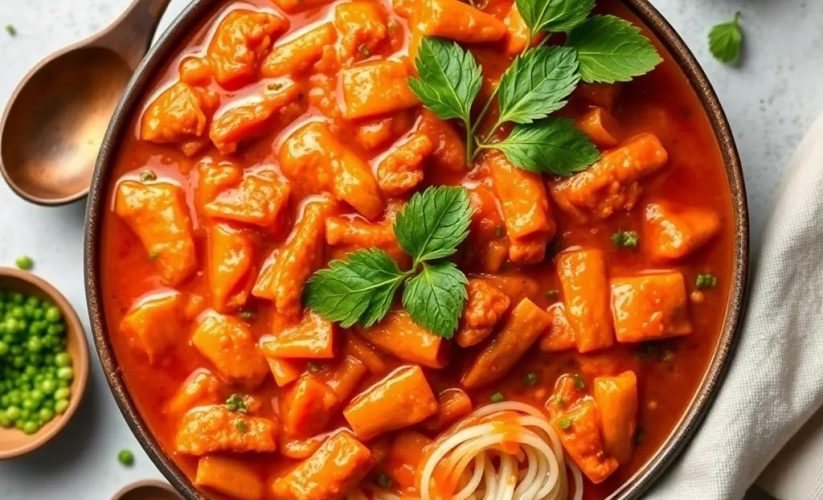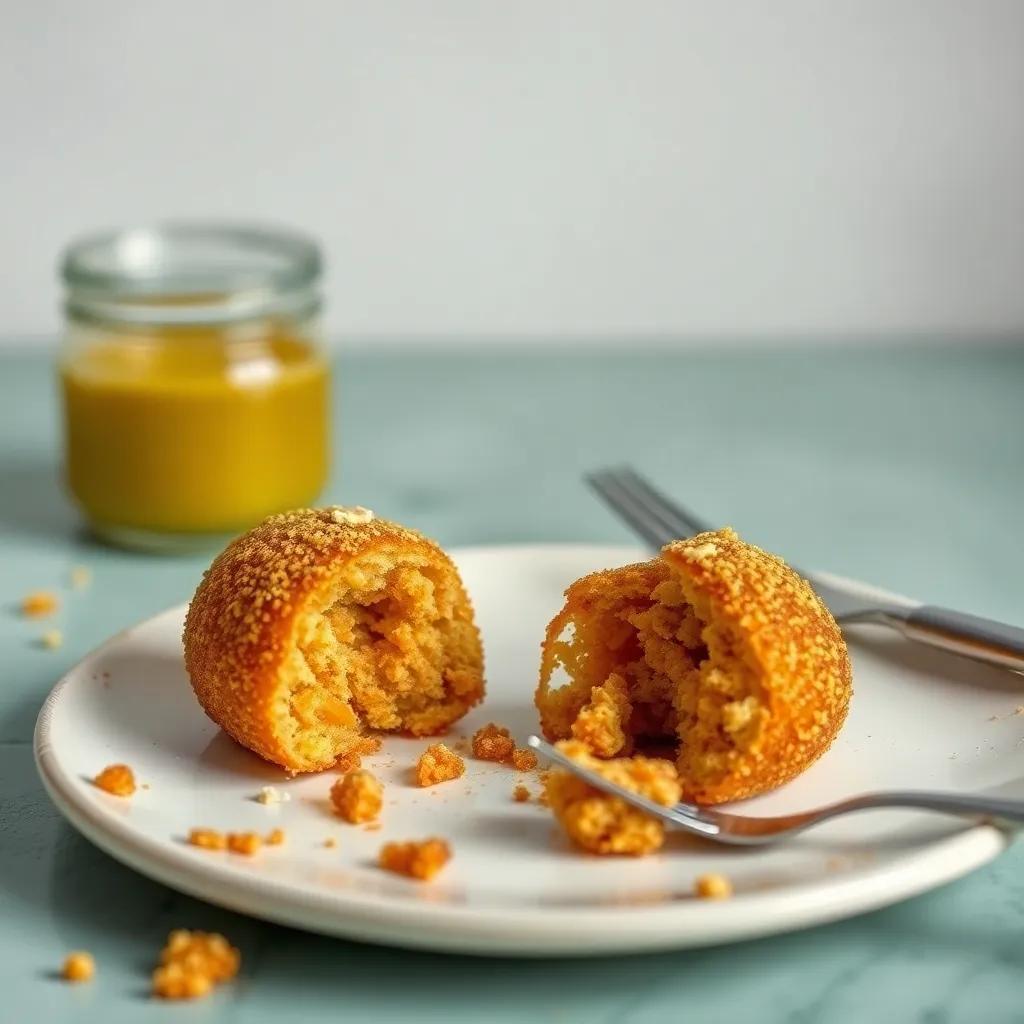Classic Spanish Pisto Recipe: Easy, Flavorful Vegan Delight

Classic Spanish Pisto Recipe: Easy, Flavorful Vegan Delight
🌍 Cuisine: Spanish
⚙️ Difficulty: Easy
Ingredients
Nutrition Facts
150
Instructions
- Heat the olive oil in a large skillet or frying pan over medium heat.
- Add the chopped onion and sauté for about 5 minutes, until softened and translucent.
- Stir in the minced garlic and cook for another 1 minute, being careful not to burn it.
- Add the diced red and green bell peppers; cook for about 8 minutes until softened, stirring occasionally.
- Stir in the diced zucchini and continue cooking for another 7 minutes until tender.
- Add the chopped tomatoes (or crushed tomatoes) and tomato paste, mixing well.
- Sprinkle in the smoked paprika, salt, and black pepper to taste.
- Reduce the heat to low and simmer the mixture uncovered for about 10-15 minutes, stirring occasionally, until the flavors meld and the sauce thickens.
- Taste and adjust seasoning if necessary.
- Remove from heat and let it rest for a few minutes to enhance flavors.
- Garnish with freshly chopped parsley before serving.
- Serve warm as a main course or side dish.
Serving Suggestions
- Serve with crusty bread or toasted baguette slices to soak up the sauce.
- Pair with vegan rice or quinoa for a more filling meal.
- Top with a fried or poached egg if not strictly vegan.
- Use as a topping for crustless vegan pizzas or flatbreads.
- Serve alongside roasted potatoes or grilled vegetables for extra texture.
- Add some olives or roasted eggplant for more Mediterranean flair.
- Chill leftovers and use as a flavorful spread for sandwiches.
Table of Contents
- Intro
- Ingredient Notes
- Tips & Variations
- Leftovers & Storage
- Behind the Recipe
- FAQ
- Your Turn in the Kitchen

Intro
Warm, comforting, and brimming with vibrant Mediterranean flavors, this Classic Spanish Pisto is a celebration of simple ingredients coming together in perfect harmony. Whether you’re seeking a wholesome weeknight dinner or a colorful side to elevate your gatherings, this dish fits seamlessly into any occasion. Its effortless preparation makes it an inviting choice for cooks of all levels — no elaborate techniques or hours at the stove are needed to create something truly satisfying.
What makes this recipe especially exciting is how it captures the essence of Spanish home cooking: rustic, fresh, and soulful. Pisto’s naturally vegan and light profile offers a fresh alternative to heavier mains, making it an ideal centerpiece during warmer months or anytime you crave a healthful, vegetable-forward meal. Serve it on its own, paired with crusty bread, or alongside grains, and you have a dish that effortlessly adapts to your mood and menu.
In essence, making pisto doesn’t just fill your kitchen with enticing aromas — it invites you to slow down, savor the seasonal bounty, and enjoy a timeless classic that’s as nourishing as it is delicious.
Ingredient Notes
When it comes to crafting an authentic and flavorful Spanish pisto, a few key ingredients make all the difference in achieving the dish’s vibrant character and satisfying texture. Understanding these essentials can elevate your cooking experience and ensure every bite captures that classic Mediterranean charm.
Olive Oil
Arguably the backbone of pisto’s rich flavor, good-quality olive oil imparts a subtle fruitiness and smooth mouthfeel that ties the vegetables together. For the best results, choose extra virgin olive oil with a balanced, slightly peppery taste — ideally from Spain or the Mediterranean region. Avoid overly mild or bland oils, as they can leave the dish tasting flat. If you prefer a lighter option, you can reduce the oil slightly, but don’t skip it completely, as it helps soften the vegetables and build depth during sautéing.
Smoked Paprika (Pimentón)
This smoky spice lends pisto its unmistakable warmth and a whisper of complexity that sets it apart from other vegetable stews. Spanish smoked paprika comes in sweet (dulce), bittersweet (agridulce), and hot (picante) varieties; for this recipe, a sweet smoked paprika is recommended to maintain balance without overpowering the gentle vegetable medley. If smoked paprika isn’t available, regular sweet paprika can be used, but adding a tiny pinch of smoked chili powder or a dash of liquid smoke can help mimic that signature smoky note.
Ripe Tomatoes
Tomatoes provide the saucy, tangy foundation for pisto’s luscious texture. Fresh, ripe tomatoes are ideal when in season — look for firm yet juicy fruit with vibrant red skin and a fragrant aroma. If fresh tomatoes aren’t available or you want to save time, high-quality canned crushed tomatoes are a perfectly acceptable substitute. Whichever you choose, peeling fresh tomatoes before chopping helps prevent bits of skin floating in the final dish, enhancing its silky consistency.
Zucchini
This humble vegetable acts as a tender, neutral canvas that absorbs surrounding flavors beautifully while adding gentle body to the stew. Selecting firm zucchinis that aren’t too large is key; mature zucchinis can develop large seeds and a spongier texture that may affect the overall mouthfeel. If zucchini isn’t on hand, yellow summer squash serves as a great alternative, offering a similar texture and mild sweetness without altering the dish’s essence.
By paying attention to these core ingredients and selecting them thoughtfully, you’ll nurture the authentic taste and rustic charm that make Classic Spanish Pisto a timeless vegan delight.
Tips & Variations
To elevate your Classic Spanish Pisto and make it truly your own, here are some expert tips and tasty variations to explore:
- Layer the Flavors Slowly: For a richer, deeper taste, sauté the vegetables gently and separately at first—starting with the onions and garlic, then peppers, followed by zucchini. This staged cooking helps each element develop its unique sweetness before they mingle. Patience here pays off with more complex flavor layers.
- Balancing Texture: If you prefer a chunkier pisto, chop vegetables into larger, rustic pieces and reduce the cooking time slightly to retain some bite. For a smoother, stew-like consistency, dice finely and simmer a bit longer until the vegetables break down and meld.
- Custom Spice Twists: While smoked paprika anchors the dish, you can experiment by adding a pinch of ground cumin for earthiness or a dash of cayenne pepper for heat. A splash of sherry vinegar or a squeeze of lemon just before serving adds a fresh, bright contrast to the simmered veggies.
- Adding Umami Boosters: To deepen the savoriness without compromising the vegan profile, consider stirring in a spoonful of miso paste or a sprinkle of nutritional yeast near the end of cooking. These additions bring a subtle, appetizing complexity.
- Vegetable Swaps & Additions: Pisto thrives on seasonal bounty. Feel free to swap zucchini for eggplant or add finely diced mushrooms for a meaty texture. Summer squash, cherry tomatoes, or even diced carrots can bring new dimensions without losing authenticity.
- Make It Gluten-Free & Vegan-Friendly: This classic recipe is naturally vegan and gluten-free, but if serving alongside gluten-containing sides (like bread), try pilaf made from quinoa, millet, or rice to keep the meal free of gluten. Also, avoid adding any non-vegan toppings if strict veganism is desired.
- Serve Warm or Cold: Though traditionally enjoyed warm, pisto tastes just as delightful chilled as a salad or topping for bruschetta, making it versatile for picnics and summer mezze spreads.
- For a Heartier Meal: Stir in cooked chickpeas, white beans, or lentils to up the protein content, transforming the dish into a satisfying one-pot meal perfect for cooler days.
By keeping these tips in mind and embracing creative substitutions, you’ll find making pisto is as versatile as it is delicious—allowing you to adapt this timeless Spanish classic to your pantry, palate, and lifestyle.
Leftovers & Storage
After enjoying your vibrant and soulful Spanish pisto, you might find yourself with some delicious leftovers ready to brighten up another meal. Proper storage not only preserves the dish’s fresh flavors but also keeps its wholesome texture intact, making it perfect for quick lunches, hearty snacks, or an easy dinner base.
To store your pisto, allow it to cool to room temperature first—this helps prevent condensation and prolongs freshness. Transfer the leftovers to airtight containers, preferably glass or BPA-free plastic, which help maintain flavor and minimize odor absorption. Dividing the pisto into single-serving portions is an excellent way to facilitate easy reheating and meal prepping.
In the refrigerator, your pisto will stay fresh for about 3 to 4 days. Keep it sealed tightly to avoid drying out, and remember to give it a gentle stir before reheating to re-blend its saucy goodness. When warming, use a stovetop skillet or microwave it in short intervals, stirring occasionally to ensure even heating without overcooking.
If you want to store pisto for longer, it freezes beautifully. Place cooled portions in freezer-safe containers or heavy-duty zip-top bags, removing as much air as possible. Label them with the date, and you can expect the pisto to maintain its quality for up to 2 to 3 months in the freezer. Thaw overnight in the refrigerator or gently defrost in a microwave, then warm through on the stove.
Thanks to its vegetable-forward nature, pisto also makes a fantastic candidate for meal prep. Prepare a larger batch ahead of time, portion it out, and pair with grains, roasted potatoes, or your choice of protein throughout the week. It can even transform into a quick sauce base for pasta or an unexpected sandwich spread when chilled, showcasing its flexibility in the kitchen.
In summary, with mindful cooling, airtight storage, and simple reheating, your pisto leftovers will remain a convenient, nourishing, and flavorful option to enjoy well beyond the first serving.
Behind the Recipe
Classic Spanish Pisto carries with it the spirit of rural Spain—an ode to the humble yet vibrant bounty of Mediterranean gardens. Rooted in regions like La Mancha and Andalusia, pisto traditionally served as a way to celebrate late summer harvests, transforming simple vegetables into a comforting stew that’s both nourishing and deeply satisfying. This dish reflects the ethos of Spanish home cooking: minimal fuss, maximum flavor, and heartfelt sharing.
The origins of pisto can be traced back centuries, often considered the Spanish cousin of ratatouille or the Italian caponata. Historically, it was a frugal farmer’s meal, relying on seasonal produce and olive oil to create a dish that’s as sustainable as it is tasty. Over time, pisto became a household staple, embodying the rustic charm of Spanish culinary tradition. Whether eaten alone or as an accompaniment to bread, eggs, or meats, it resonates with simplicity and warmth.
On a personal note, this recipe invites you to partake in that timeless tradition—even in modern kitchens far from Spanish fields. Many families cherish pisto as a weekend ritual, a way to slow down and savor the flavors of fresh vegetables gently coaxed into harmony. Cooking and sharing pisto is as much about the experience as the flavors—a reminder that food connects us across cultures and time.
By preparing this classic vegan pisto, you’re embracing a dish that is not only delicious and easy to make but also steeped in history and community. It’s a culinary story told through every sizzle of olive oil and tender bite of ripe vegetables—a truly meaningful way to bring a taste of Spain to your table.
FAQ
Can I substitute other vegetables if I don’t have all the ingredients?
How long can I store leftover Pisto, and what’s the best way to reheat it?
Is this recipe suitable for people with gluten or nut allergies?
Can I add protein to make this a more filling meal?
What’s the best way to enhance the flavor without adding meat or dairy?
Can I prepare Pisto ahead of time for meal prepping?
Your Turn in the Kitchen
There’s something truly timeless about this classic Spanish pisto—a vibrant, wholesome medley of fresh vegetables that comes together effortlessly to create a flavorful vegan delight. Whether you’re new to Spanish cuisine or simply seeking a comforting, healthy dish, this recipe invites you to savor simplicity and freshness in every bite.
We’d love to hear how your pisto turns out! Feel free to leave a comment, share your favorite twists, or rate the recipe to help fellow cooks discover this gem. Happy cooking and buen provecho!












